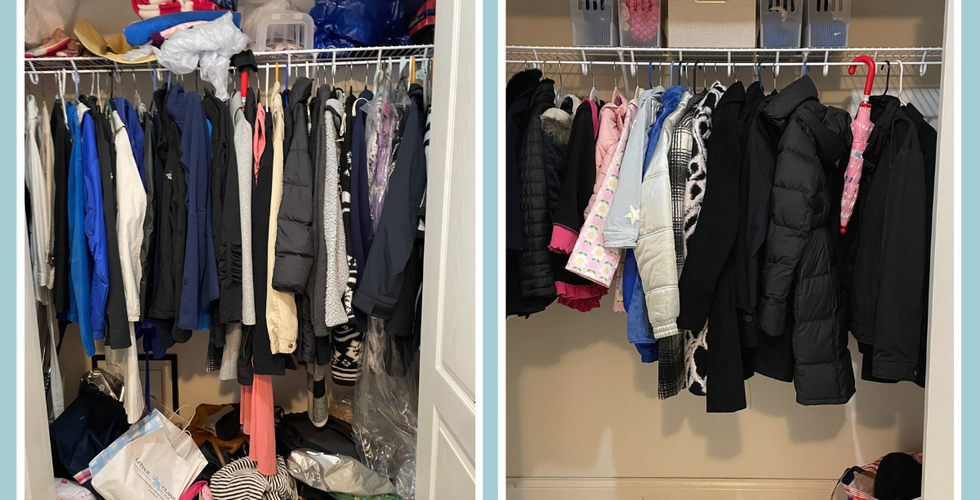Learn how to start small, shop smarter, and reduce incoming purchases for a simpler, clutter-free home! Discover practical strategies to create lasting organization, avoid common pitfalls, and start transforming your space.
DISCLOSURE: THIS POST CONTAINS AFFILIATE LINKS, MEANING I MAY GET A SMALL COMMISSION IF YOU DECIDE TO MAKE A PURCHASE USING LINKS PROVIDED. HOWEVER, THERE IS NO COST TO YOU. AS AN AMAZON ASSOCIATE, I EARN FROM QUALIFYING PURCHASES. VIEW THE FULL DISCLOSURE HERE
I was recently featured on Live from Chevy Chase to provide a couple of quick tips on how you can ease your way into decluttering this year. To catch the short 5-minute video, skip to the bottom. If you would prefer some lighter reading, start below.
Decluttering your home can feel overwhelming, but it doesn’t have to be! By breaking it down into manageable steps and staying intentional, you can create a space that feels light, organized, and uniquely yours. Ready to dive in? Here are three game-changing strategies to kickstart your journey.
1. Start Simple: Tackle Small, Non-Sentimental Items First
When you’re just starting out, it’s best to keep things simple. Tackling non-sentimental items first can help ease you into the process without the emotional weight of dealing with keepsakes or memorabilia.
By starting small, you’ll build confidence and momentum—and before you know it, you’ll be ready to take on bigger projects! Here are two of my favorite recommendations for where to start!
Recommendation 1: Any Small Closet
For example use a coat closet or hall closet. This is a quick win in a space you use all the time. Start by taking everything out. Assess what you actually wear and let go of anything that no longer serves you. (That jacket you haven’t worn in three winters? It’s time to say goodbye.)
Bonus Idea: Want to maximize functionality? Consider repurposing your coat closet into a mini mudroom or how about a shoe closet. Make the space work harder for your personal everyday needs.
Swipe through to grab some inspo for your small closet.
Recommendation 2: The Junk Drawer
Ah, the infamous junk drawer—we all have one, sometimes we have four or five! Dive in with a trash can in hand and start purging. Expired coupons, dried-up pens, and random screws whose origins are a mystery? Let them go!
But as soon as I toss that one bolt, I just KNOW I finally learn where it was supposed to go? I hear and here's my answer - just head to Lowe’s or Home Depot. They’ve got all the random bolts you’ll ever need, so you don’t have to play 'keeper of the useless hardware' anymore!
Bonus Idea: Found a gift card in the chaos? Digitize it! Add Amazon cards directly to your account or upload restaurant gift cards to their apps. At the very least, put those cards in your purse or car so you’ll actually use them.
By starting with these small spaces, you’ll gain an immediate sense of accomplishment and set the tone for tackling larger, more complex areas later.
2. Organize Smarter: Pick The Correct Tool For The Job
We’ve all been there—strolling through Target’s Dollar Spot or wandering HomeGoods, tempted by cute bins and organizers. But here’s the truth: most of those well-intentioned purchases end up as clutter themselves.
Why They Fail:
They’re the wrong size for your space—too big, too small, or just plain impractical.
They don’t fit how your family functions. What works for one household might not work for yours.
They’re often used to hide clutter rather than organize it.
The Solution: Declutter first.Take a step back, clear out what you no longer need, and assess what’s staying. Measure your space (whether it’s a shelf, drawer, or closet) and only then decide what storage solutions make sense. You might even find you don’t need new supplies at all!
Pro Tip: By skipping impulse buys and focusing on decluttering, you’ll save money, reduce frustration, and create a system that truly works for your lifestyle.
Here are just two examples of using random organizing products compared to being intentional about what you choose—because a little thought can make all the difference in creating a system that truly works.
3. Stay Intentional: Make Mindful Purchases for a Clutter-Free Home
The best way to reduce future clutter? Be intentional about what you bring into your home. Many of the items you’re decluttering were once things you chose to buy. Some were great decisions, but others—impulse buys, sale finds, or gifts from well-meaning friends—became part of the clutter problem. Bonus tip on incoming gifts at the end.
How many times have you ordered something online, realized it wasn’t what you needed, and missed the return window? It ends up in the back of a closet, becoming part of the “closet of shame.” Sound familiar?
Here’s the Fix:
Before making a purchase, pause and ask yourself:
Do I really need this?
Will I actually use it?
Do I already have something similar?
Do I have space for it?
Is this solving a real problem, or am I creating more clutter?
By being more mindful, you’ll save money, avoid clutter, and build a home that reflects what matters most to you. So down before you click the "add to cart" button!
Pro Tip: If an item isn’t a clear “yes,” it’s probably a no. Future-you will thank you for making thoughtful choices today.
Bonus Tip: Rethink gift-giving and receiving. Instead of physical items, consider experiential gifts that don’t contribute to clutter. Gift a zoo membership, tickets to a big sporting event, or swim lessons for young kids. Celebrate friendships by going out for a phone-free evening together rather than exchanging scarves or knick-knacks that might not get used. These thoughtful, clutter-free alternatives create meaningful memories while keeping your home—and the homes of your loved ones—organized and intentional.
Final Thoughts
Decluttering isn’t a one-and-done task—it’s an ongoing process of maintaining the spaces you’ve worked so hard to simplify. By building daily habits, like putting items back in their designated spots and being mindful of new purchases, you’ll keep your home clutter-free over time. Remember, progress is more important than perfection. Celebrate the small wins and keep going—your organized, happy home is a work in progress!
Here, enjoy this video for quick decluttering inspiration! For more videos like this, check out my YouTube channel here.






















Comments